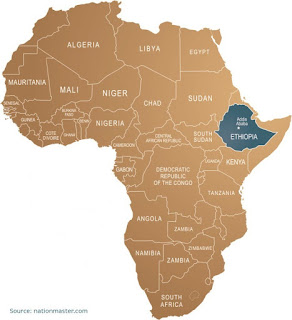Is Ethiopia Actually Water Scarce?
I was having a read through my blog this morning and I realised that over the past few weeks I might have been giving off the notion that Ethiopia is a country is facing dire physical water scarcity. However, this was the idea I was attempting to move away from at the start of my blog, that Africa isn’t the parched continent it is often believed to be. Indeed, water scarcity is generally portrayed as an issue of thirst, yet it is more often the case that financial restrictions or poor water management are ultimately responsible for a lack of water. Ethiopia is no exception and, as I’ll illustrate in this post, the necessary water needed for food production is most definitely available.
Although it is, of course, true that parts of Ethiopia receive very low levels of precipitation (see Figure 2), the nation as a whole is home to some of the most substantial water reserves in Africa, earning it the title of the “water tower of Eastern Africa”. The majority of these water reserves come from 12 main river basins (see Figure 1), providing an estimated mean annual flow of 122 billion cubic metres (BMC). Figure 2 illustrates the actual location of rainfall throughout Ethiopia and reveals that much of the country receives more than the 500mm of rainfall deemed necessary for sustaining worthwhile crop yields. Furthermore, whilst Ethiopia’s groundwater potential is less substantial than its water resources at the surface, there could still be at least 2.6 BMC of extractable annually recharging groundwater, although some studies put the figure much higher at 6.6 BMC. Therefore, if groundwater was to be properly utilised, it could support increased agricultural production on a substantial scale.
 |
| Figure 1: Map showing Ethiopia's 12 river basins |
 |
| Figure 2: Map showing the intensity and spatial distribution of rainfall throughout Ethiopia |
Despite the apparent abundance of water resources, Ethiopia has an astoundingly low water withdrawal rate of just 2%. On top of this, only 40% of Ethiopia's arable land, estimated to be around 3.7 million hectares, is being utilised for agricultural production. When combined with extremely low irrigation rates, with irrigated land taking up just 150,000 to 250,000 hectares and contributing only 2.46% to the total food production, it becomes easier to understand why Ethiopia continues to struggle with food security. It is this heavy dependence on rain-fed agriculture which has made the country’s food production so vulnerable to the fluctuations I’ve discussed recently.
I hope that it is now more apparent that Ethiopia has sufficient water to sustain food production. This does not mean that the declines in rainfall, inter and intra-annual fluctuations and growing population are not putting immense strain on the current water and agricultural system; but it is important to understand that through improving the system it is often possible to overcome these hurdles. Indeed, Africa is the region with the most untapped potential for increasing agricultural output and through improving its water management systems, such as water harvesting, storage and distribution, Ethiopia could realise this potential. In my next post I’ll therefore be having a look at the improvements Ethiopia could make to its irrigation systems to promote food security by drawing comparisons with systems already in place in Egypt.



Comments
Post a Comment